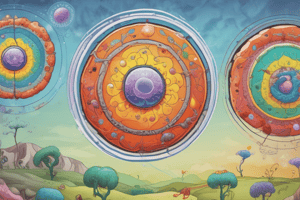Podcast
Questions and Answers
What phase comes immediately after the S phase in the eukaryotic cell cycle?
What phase comes immediately after the S phase in the eukaryotic cell cycle?
- G0 phase
- Cytokinesis
- M phase (correct)
- G1 phase
The G1 phase is primarily responsible for DNA replication.
The G1 phase is primarily responsible for DNA replication.
False (B)
What is the role of cyclins in the cell-cycle control system?
What is the role of cyclins in the cell-cycle control system?
Cyclins activate cyclin-dependent protein kinases (Cdks) at appropriate times in the cell cycle.
The phase during which a cell replicates its DNA is called the ______.
The phase during which a cell replicates its DNA is called the ______.
Match the following phases of the cell-cycle with their descriptions:
Match the following phases of the cell-cycle with their descriptions:
What triggers the S phase of replication?
What triggers the S phase of replication?
Cdc25 is activated when DNA replication is damaged.
Cdc25 is activated when DNA replication is damaged.
What role does M-Cdk play in the transition from G2 to M phase?
What role does M-Cdk play in the transition from G2 to M phase?
During S phase, S-Cdk helps prevent re-replication by phosphorylating Cdc6 to mark it for __________.
During S phase, S-Cdk helps prevent re-replication by phosphorylating Cdc6 to mark it for __________.
Match each protein with its primary function during cell cycle regulation:
Match each protein with its primary function during cell cycle regulation:
Flashcards
Cell Cycle
Cell Cycle
A series of events that leads to cell duplication and division
Interphase
Interphase
The period between cell divisions, where cell growth and DNA replication happen.
S Phase
S Phase
The stage of interphase where DNA replicates.
Cell Cycle Control System
Cell Cycle Control System
Signup and view all the flashcards
CDK
CDK
Signup and view all the flashcards
ORC recruitment
ORC recruitment
Signup and view all the flashcards
S-Cdk activation
S-Cdk activation
Signup and view all the flashcards
Cdc6 degradation
Cdc6 degradation
Signup and view all the flashcards
G2 arrest
G2 arrest
Signup and view all the flashcards
M-Cdk activation
M-Cdk activation
Signup and view all the flashcards
Study Notes
Cell Division Cycle
- Cell cycle is a process of duplication and division
- Eukaryotic cell cycle generally includes four phases:
- Mitosis and cytokinesis (M phase)
- Interphase (period between M phases)
- S phase (synthesis) - DNA replicates
- G1 and G2 phases - cell growth and prepares for DNA replication, monitors internal&external environments
Cell Cycle Control System
- Ensures events in the cycle occur completely and in order
- Has checkpoints at critical points of the feedback cycle
- Checks for suitable conditions and nutrient levels before DNA replication
- Checks for undamaged and fully replicated DNA before mitosis
- Checks for attached duplicated chromosomes before separation
Cell Cycle Control System depends on Cyclically Activated Protein Kinases (Cdks)
- Activating and inactivating key proteins through phosphorylation/dephosphorylation
- Protein kinases are important for G1 to S, Then another kinase for M Phase into Mitosis
- Cyclins are proteins in the control system that switch kinases on/off
- No enzymatic activity, but bind to kinases before activation
- Cdks are protein kinases (cyclin-dependent kinase) activate by binding with Cyclins
- Different cyclin-cdk complexes trigger different steps in the cell cycle
- M cyclin initiates M phase (forms M-Cdk)
- S and G1/S cyclins form S-Cdk and trigger S phase
Cyclin Concentrations
- Regulated by transcription and proteolysis
- Gradual increase in cyclin due to transcription of cyclin genes, rapid fall due to targeted destruction.
- Anaphase-promoting complex (APC) degrades M and S cyclins during mitosis.
- Ubiquitylation and degradation of cyclin inactivates associated Cdk.
Cdk activity
- Can be blocked by Cdk inhibitor proteins
- Inhibits assembly/activity of cyclin-Cdk complexes
- Can pause cycle at G1 to S and G2 to M transitions
G1 Phase
- Metabolic activity, cell growth and repair
- Cdks are inactivated to prevent immediate DNA replication
- Mitogens promote the production of cyclins that stimulate cell division (signals from other cells)
S Phase
- S-Cdk initiates DNA replication and blocks re-replication
- Origins of replication are specific nucleotide sequences
- Origin Recognition complex (ORC) and protein Cdc6 recruit DNA helicases
- S-Cdk helps in preventing re-replication of DNA.
Incomplete Replication Arrest
- The cell cycle can delay entry to M Phase if there are DNA replication errors or delays
Mitosis (M Phase)
- Cell recognizes components and distributes them equally to daughter cells
- M-Cdk helps in the processes
- Cohesins & Condensins help configure duplicated chromosomes for separation
- Mitotic spindle helps with nuclear division in mitosis, contractile ring with cytoplasm division
- Centrosomes are duplicated to form two poles of the mitotic spindle.
- Duplicated chromosomes align in the metaphase plate at the spindle equator
- Proteolysis triggers sister chromosome separation in anaphase
- Chromosome segregation occurs in anaphase
- Anaphase A: Kinetochore MTs shorten, pulling chromosomes to poles
- Anaphase B: Spindle poles move apart
Cytokinesis
- Cytoplasm division completes M phase
- Mitotic spindle determines cleavage plane
- Cytokinesis in animal cells uses actin and myosin filaments for the contractile ring
- Cytokinesis in plants includes formation of a new cell wall through a phragmoplast
Apoptosis
- Cell death regulated by an intracellular proteolytic cascade (caspases).
- Intrinsic and Extrinsic pathways for regulating apoptosis
- Intrinsic pathway is regulated by Bcl2 family proteins.
- Extracellular signals can initiate apoptosis via death receptors.
- Survival factors suppress apoptosis.
Other control processes
- Growth factors stimulate cell growth and proliferation
- Mitogens stimulate cell division (allowing entry into S Phase)
Studying That Suits You
Use AI to generate personalized quizzes and flashcards to suit your learning preferences.
Related Documents
Description
Explore the intricate processes of the cell cycle, including the phases of mitosis and cytokinesis. Learn about the crucial checkpoints that ensure proper cell division and the role of Cyclin-dependent kinases (Cdks) in regulating these events.




